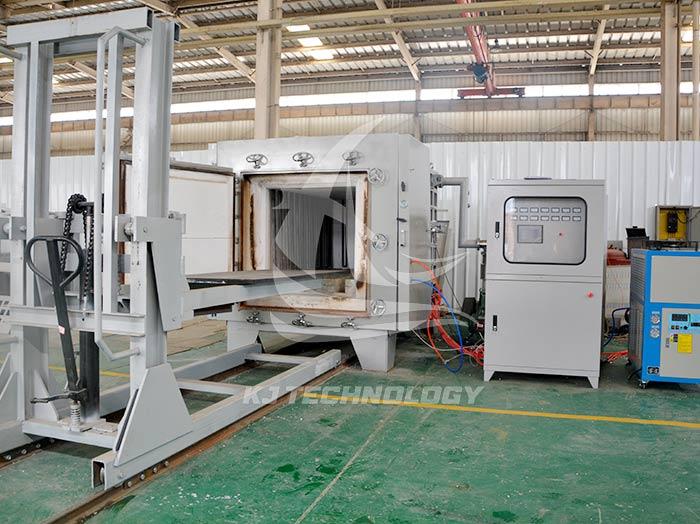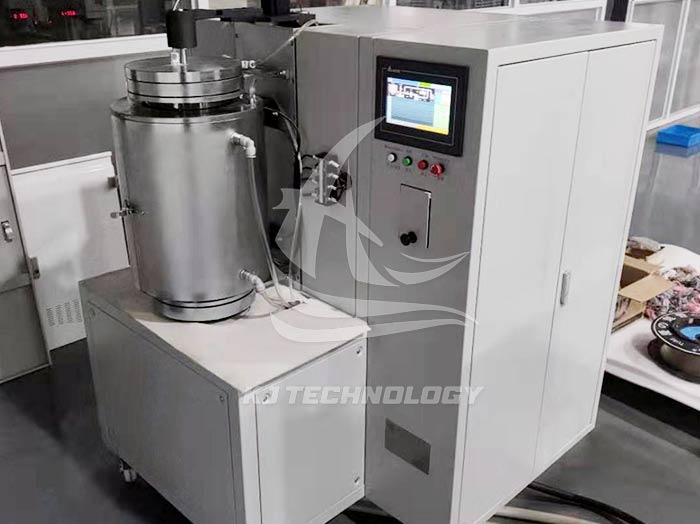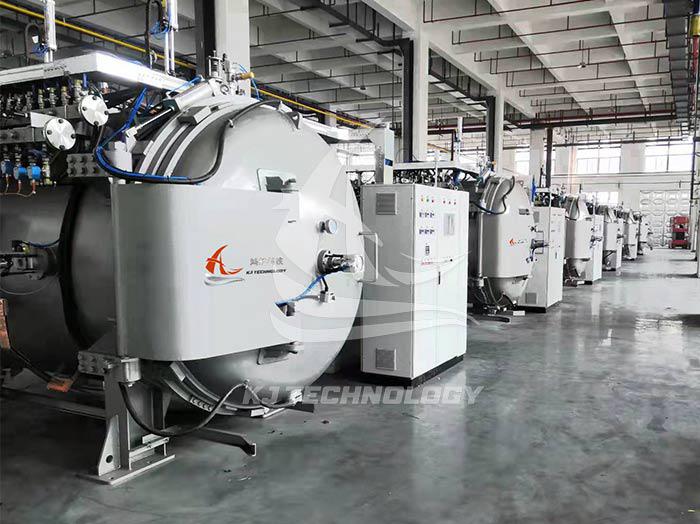What are the applications of vacuum atmosphere muffle furnace?
 09-12-2025 Author: KJ technology
09-12-2025 Author: KJ technology
The vacuum atmosphere muffle furnace has been widely used in materials science, industrial manufacturing, new energy, semiconductors, aerospace and other fields due to its vacuum environment control, atmosphere regulation and high-temperature heating capabilities. The following are its core application scenarios and specific cases:
1. Materials Science and R&D
Metal material processing
Annealing and stress relief:
Heating metal to critical temperature in vacuum or inert gas (such as argon) to eliminate processing stress and improve plasticity.
Case: After vacuum annealing, the fatigue life of titanium alloy aviation parts is improved and used in the manufacturing of aircraft landing gear.
Carburizing and nitriding:
Introduce hydrocarbons (such as methane) or ammonia gas to form a high hardness carbide or nitride layer on the metal surface.
Case: After vacuum carburizing treatment, the surface hardness of automotive gears is high and their wear resistance is improved.
Ceramic material synthesis
High temperature sintering:
Heating ceramic powder in a vacuum or nitrogen atmosphere to 1600-1800 ℃ promotes particle bonding and increases density.
Case: After vacuum sintering, alumina ceramics have high bending strength and are used for tool coating.
Preparation of nitrides/carbides:
Nitrogen or methane is introduced to synthesize silicon nitride (Si ∝ N ₄) or silicon carbide (SiC) ceramics, which have high hardness and high temperature resistance characteristics.
Case: Silicon nitride bearing balls maintain high strength at 1200 ℃ and are used for high-speed machine tool spindles.
Preparation of composite materials
Chemical Vapor Deposition (CVD):
Gas reactants (such as silane and methane) are introduced into a high-temperature vacuum environment to deposit a thin film on the substrate surface.
Case: Deposition of diamond film on silicon wafer with high thermal conductivity, used for heat dissipation of high-power electronic devices.
Carbon fiber carbonization:
Heat polyacrylonitrile (PAN) based fibers to 1500 ℃ in a nitrogen atmosphere to convert them into high-strength carbon fibers.
Case: Carbon fiber composite materials are used for rocket shells to reduce weight and improve structural strength.
2. In the field of new energy and environmental protection
Production of lithium battery materials
Sintering of positive electrode material:
Heat the precursor of lithium iron phosphate (LiFePO ₄) in an oxygen or air atmosphere to 700-800 ℃ to form a stable crystal form.
Case: Vacuum sintered LiFePO ₄ cathode material with high battery capacity and long cycle life.
Graphitization of negative electrode material:
Heat artificial graphite in an argon atmosphere to 2800 ℃ to increase crystallinity and reduce resistivity.
Case: Graphitic negative electrode material is used for power batteries to improve fast charging performance.
Hydrogen energy technology
Catalyst preparation:
Heating platinum (Pt) or nickel (Ni) precursors in a hydrogen atmosphere to synthesize highly active catalyst particles.
Case: Pt/C catalyst is used in fuel cells for higher energy density and longer lifespan.
Hydrogen storage material processing:
Heating metal hydrides (such as LaNi ₅) under vacuum releases adsorbed hydrogen gas to achieve material regeneration.
Case: LaNi ₅ hydrogen storage tank is used for hydrogen powered vehicles, reducing hydrogen charging time.
Environmentally friendly material processing
Regeneration of waste catalyst:
Heating deactivated automotive exhaust catalysts (such as CeO ₂ - ZrO2) in air or oxygen atmosphere to restore oxidation activity.
Case: Recovery of NOx conversion efficiency and cost reduction of regenerated catalyst.
Hazardous waste treatment:
Heating heavy metal containing waste (such as chromium slag) under vacuum to evaporate low boiling impurities and achieve harmless treatment.
Case: After vacuum heat treatment, the hexavalent chromium content in chromium slag decreased, meeting environmental standards.
3. Semiconductor and Electronics Industry
wafer fabrication
Annealing and activation:
Heat silicon wafers in a hydrogen or argon atmosphere to 1000-1200 ℃ to repair ion implantation damage and activate dopants.
Case: Silicon wafers annealed in vacuum have improved carrier mobility and are used for chip manufacturing.
Oxidation and diffusion:
Heat the wafer in an oxygen or water vapor atmosphere to form a silicon dioxide (SiO ₂) insulation layer.
Case: SiO ₂ layer thickness control accuracy is higher, meeting the requirements of advanced processes.
Packaging and reliability testing
Chip sintering:
Heating silver paste or copper paste in a nitrogen atmosphere to achieve high thermal conductivity connection between the chip and the substrate.
Case: Silver sintered chips have high thermal conductivity and are used for high-power LED packaging.
High temperature storage test:
Heat electronic components in air or inert gas to 150-200 ℃, simulate long-term usage environment, and evaluate their lifespan.
Case: The capacitor tested at 200 ℃/1000h has stable leakage current.
4. Aerospace and high-end manufacturing
High temperature alloy treatment
Hot isostatic pressing (HIP):
Apply high temperature (1000-1200 ℃) and high pressure (100-200MPa) to powder metallurgy parts in a vacuum or argon atmosphere to eliminate pores.
Case: HIP treated nickel based high-temperature alloy turbine disk with high density, used for aircraft engines.
Directional solidification:
Control the cooling rate under vacuum to promote the growth of metal single crystals in a specific direction and enhance their high-temperature strength.
Case: Directional solidification nickel based single crystal blades with a temperature bearing capacity of 1150 ℃, used for heavy-duty gas turbines.
Precision parts processing
Jewelry purification and casting:
Heat the gold containing impurities under vacuum to 1064 ℃ to evaporate low boiling point impurities and improve purity.
Case: Vacuum cast gold jewelry with high surface glossiness and no porosity defects.
Optical component coating:
Under vacuum, a coating material (such as magnesium fluoride) is evaporated by electron beam to form an anti reflective or reflective film.
Case: The transmittance of the coated optical lens is improved and used for satellite remote sensing cameras.
5. Other featured applications
Archaeology and Cultural Relics Protection
Bronze restoration:
Heat corroded bronze ware in a hydrogen atmosphere to 200-300 ℃ to reduce the oxide layer and restore its metallic luster.
Case: A Warring States bronze sword that has been vacuum treated has a high removal rate of rust layer on the surface and clear and visible patterns.
Food and Drug Industry
Vacuum drying:
Dry thermosensitive materials (such as traditional Chinese medicine extracts) under low-temperature vacuum to avoid component decomposition.
Case: Vacuum dried Danshen extract with higher retention rate of active ingredients, used for injection production.
Geological sample analysis
Rock pyrolysis:
Heat rock samples in vacuum or inert gas to 500-800 ℃ to release organic matter and analyze the potential for oil and gas generation.
Case: Thermal decomposition experiment shows the oil content of a shale sample, guiding oil and gas exploration and development.








